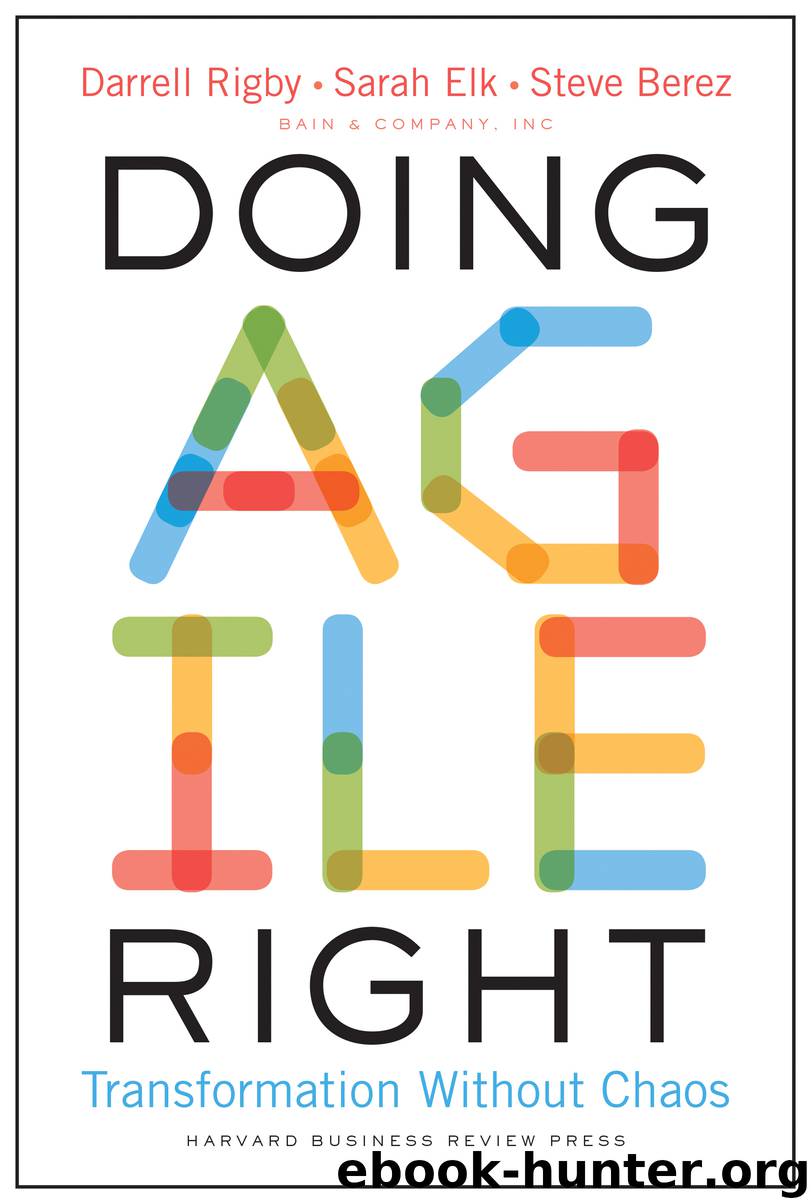Doing Agile Right by Steven H. Berez & Sarah Elk & Darrell K. Rigby

Author:Steven H. Berez & Sarah Elk & Darrell K. Rigby [Steven H. Berez]
Language: eng
Format: epub
Publisher: Harvard Business Review Press
Published: 2020-05-25T16:00:00+00:00
Agile Reviewing
Reviewing is an essential part of the plan-do-study-adjust cycle. Quarterly, monthly, or even weekly reviews provide frequent opportunities to compare actual versus expected performance, and to determine whether to change plans and budgets or the activities designed to achieve them. But here, too, agile enterprises go about it differently. Participants share information in a transparent and informal way, avoiding the time and effort wasted in preparing slick presentations. They are far more likely to use reviews to update plans and budgets. Their chief goal is to boost rather than hinder the empowerment of agile teams. Reviewers want to give teams the information they need to manage a full range of business considerations, so teams can do their own reviews of topics that, in a bureaucratic organization, would be reviewed by control functions or other managers. This helps avoid excessive top-down direction.
Finance departments, for example, will always manage budgets. But financial managers don’t need to keep questioning the decisions of the owners of agile initiatives. “Our CFO constantly shifts accountability to empowered agile teams,” says Ahmed Sidky, the head of development management at the videogame company Riot Games. “He’ll say, ‘I am not here to run the finances of the company. You are, as team leaders. I’m here in an advisory capacity.’ In the day-to-day organization, finance partners [are assigned to groups of agile teams]. They don’t control what the teams do or don’t do. They are more like finance coaches who ask hard questions and provide deep expertise. But ultimately it’s the team leader who makes decisions, according to what is best for Riot players.”3
Riot Games, of course, is a digital-native company with a lot of agile experience. But RBS’s personal bank is pursuing a similar goal, adapting its quarterly budget review process to better empower its agile teams. Instead of reviewing project spending and degree of completion versus budget, the quarterly reviews now involve a much more valuable set of discussions revolving around customer business area and journey team performance agreements, including a set of agreed measurable outcomes. Owners report on outcomes achieved and on any that were missed, discussing the reasons and seeking input for improvement. This shift in reviewing focus has contributed to much greater engagement and satisfaction of the owners and their teams. At this writing, the performance agreements of change-the-business innovation teams are separate from those of run-the-business operations teams. But the bank was planning to create a unified set of goals and commitments for both kinds of teams assigned to each customer journey. It was also developing governance changes that should further increase the agility of journey teams. These changes include reducing and accelerating the steps required to approve changes that affect customers and streamlining the reporting of how funds are being used.
Dell—no surprise here—also uses reviews to update plans frequently. Each month, the executive leadership team meeting reviews the results-to-date of some ongoing strategic agenda initiatives. This creates accountability for the initiative owner to deliver promised outcomes. The process avoids the common
Download
This site does not store any files on its server. We only index and link to content provided by other sites. Please contact the content providers to delete copyright contents if any and email us, we'll remove relevant links or contents immediately.
Bad Blood by John Carreyrou(6559)
Rich Dad Poor Dad by Robert T. Kiyosaki(6414)
Principles: Life and Work by Ray Dalio(6236)
Playing to Win_ How Strategy Really Works by A.G. Lafley & Roger L. Martin(5945)
Management Strategies for the Cloud Revolution: How Cloud Computing Is Transforming Business and Why You Can't Afford to Be Left Behind by Charles Babcock(4528)
The Confidence Code by Katty Kay(4193)
Thinking in Bets by Annie Duke(4154)
American Kingpin by Nick Bilton(3762)
Delivering Happiness by Tony Hsieh(3369)
Project Animal Farm: An Accidental Journey into the Secret World of Farming and the Truth About Our Food by Sonia Faruqi(3179)
The Power of Habit by Charles Duhigg(3064)
The Tyranny of Metrics by Jerry Z. Muller(3008)
Brotopia by Emily Chang(3002)
Mastering Bitcoin: Programming the Open Blockchain by Andreas M. Antonopoulos(2986)
The Marketing Plan Handbook: Develop Big-Picture Marketing Plans for Pennies on the Dollar by Robert W. Bly(2978)
I Live in the Future & Here's How It Works by Nick Bilton(2941)
The Content Trap by Bharat Anand(2864)
Building a StoryBrand by Donald Miller(2844)
Applied Empathy by Michael Ventura(2839)
